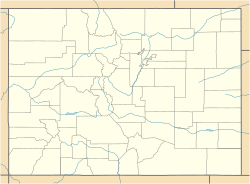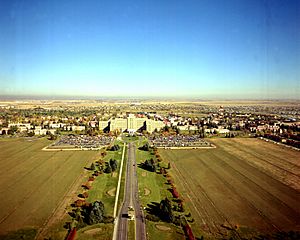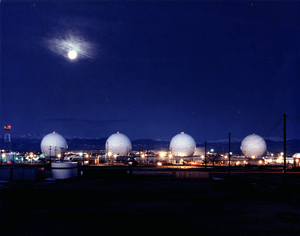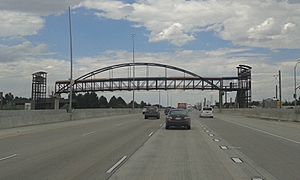Aurora, Colorado facts for kids
Quick facts for kids
Aurora
|
|||
|---|---|---|---|
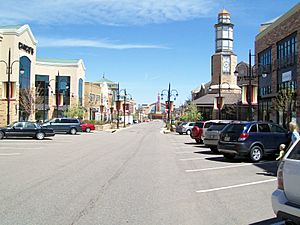
The Southlands, an Aurora-based shopping mall
|
|||
|
|||
| Nicknames:
The Gateway to the Rockies
The Sunrise of Colorado |
|||
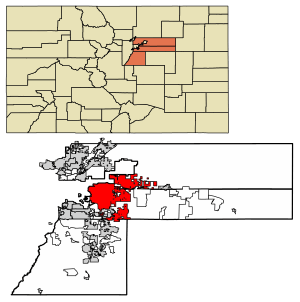
|
|||
| Country | |||
| State | |||
| Counties | Arapahoe Adams Douglas |
||
| Platted | 1891 as Fletcher, Colorado | ||
| Incorporated (town) | May 5, 1903, as the Town of Fletcher | ||
| Incorporated (city) | March 9, 1928 as the City of Aurora | ||
| Government | |||
| • Type | Home rule municipality | ||
| Area | |||
| • Total | 423.691 km2 (163.588 sq mi) | ||
| • Land | 422.191 km2 (163.009 sq mi) | ||
| • Water | 1.500 km2 (0.579 sq mi) | ||
| Area rank | 2nd in Colorado 54th in the United States |
||
| Elevation | 1,694 m (5,558 ft) | ||
| Population
(2020)
|
|||
| • Total | 386,261 | ||
| • Rank | 3rd in Colorado 52nd in the United States |
||
| • Density | 931/km2 (2,412/sq mi) | ||
| Demonym(s) | Auroran | ||
| Time zone | UTC−07:00 (MST) | ||
| • Summer (DST) | UTC−06:00 (MDT) | ||
| ZIP Codes |
80010-80019, 80040-80047 (all but 80045 PO Boxes), 80247
|
||
| Area codes | Both 303 and 720 | ||
| FIPS code | 08-04000 | ||
| GNIS feature ID | 2409757 | ||
Aurora (/əˈroʊrə/, /əˈrɔːrə/) is a home rule municipality located in Arapahoe, Adams, and Douglas counties, Colorado, United States. The city's population was 386,261 at the 2020 United States Census with 336,035 residing in Arapahoe County, 47,720 residing in Adams County, and 2,506 residing in Douglas County. Aurora is the third-most-populous city in the State of Colorado and the 52nd-most-populous city in the United States. Aurora is a principal city of the Denver–Aurora–Lakewood Metropolitan Statistical Area (MSA) and a major city of the Front Range Urban Corridor.
Contents
History
Before European settlement, the land that now makes up Aurora was the territory of the Arapaho, Cheyenne, Núu-agha-tʉvʉ-pʉ̱ (Ute), and Očeti Šakówiŋ (Sioux) tribes.
Aurora originated in the 1880s as the town of Fletcher, taking its name from Denver businessman Donald Fletcher who saw it as a real estate opportunity. He and his partners staked out four square miles (10 km2) east of Denver, but the town—and Colorado—struggled mightily after the Silver Crash of 1893. The Town of Fletcher was incorporated on May 5, 1903. Fletcher skipped town, leaving the community with a huge water debt. Voters decided to rename Fletcher the Town of Aurora in 1907 after one of the subdivisions composing the town. The Aurora post office opened on January 15, 1908.
By February 1928, the town of Aurora had reached a population of over 2,000 and it was reincorporated as a city on March 9. Aurora slowly began to grow in Denver's shadow becoming the fastest-growing city in the United States during the late 1970s and early 1980s. Aurora, composed of hundreds of subdivisions, thus carries the name of one of the original development plats from which it sprang.
Aurora's growing population in recent decades has led to efforts for co-equal recognition with its larger neighbor. Former mayor Dennis Champine once expressed the somewhat whimsical notion that eventually the area would be called the "Aurora/Denver Metropolitan Area". Indeed, since the 2000 Census Aurora has surpassed Denver in land area, and much of Aurora is undeveloped, while Denver is more fully built-out. However, such efforts are somewhat hampered by the lack of a large, historically important central business district in the city. Aurora is largely suburban in character, as evidenced by the city's modest number of multi-story buildings.
A large military presence has existed in Aurora since the early 20th century. In 1918, Army General Hospital #21 (later renamed Fitzsimons Army Hospital) opened, with the U.S. government expanding and upgrading the hospital facilities in 1941 just in time to care for the wounded servicemen of World War II. Lowry Air Force Base was opened in 1938, straddling the border of Aurora and Denver. It eventually closed in 1994, and has been redeveloped into a master-planned community featuring residential, commercial, business and educational facilities. In 1942, the Army Air Corps built Buckley Field, which has been renamed Naval Air Station, Buckley Air National Guard Base, Buckley Air Force Base, and finally Buckley Space Force Base. The base, home of the Buckley Garrison and the 140th Wing Colorado Air National Guard, is Aurora's largest employer.
President Warren G. Harding visited Fitzsimons Army Hospital in 1923, and President Franklin D. Roosevelt visited in 1936. In 1943, the hospital was the birthplace of 2004 Democratic presidential candidate John Kerry. President Dwight D. Eisenhower recovered from a heart attack at Fitzsimons for seven weeks during the fall of 1955. Decommissioned in 1999, the facility is part of the Anschutz Medical Campus of the University of Colorado Denver, and the Fitzsimons Life Science District. The Anschutz Medical Campus also includes the University of Colorado Hospital, which moved to Aurora from Denver in 2007, and the Children's Hospital. The first carbon-ion radiotherapy research and treatment facility in the U.S. has been proposed at the site. These facilities will employ a workforce of 32,000 at build-out.
In 1965, mayor Norma O. Walker became the first woman to head a U.S. city with a population over 60,000.
In 1978, the cult coming-of-age film Over the Edge was filmed in Aurora; the crime drama has been named the "signature film" of Denver.
In 1979, it was announced that a science fiction theme park would be built in Aurora using the sets of a $50 million film based on the fantasy novel Lord of Light. However, due to legal problems the project was never completed. The script of the unmade film project, renamed Argo, was used as cover for the "Canadian Caper": the exfiltration of six U.S. diplomatic staff trapped by the Iranian hostage crisis.
In 1993, Cherry Creek State Park on the southwestern edge of Aurora was the location for the papal mass of the 8th World Youth Day with Pope John Paul II, attended by an estimated 500,000 people.
Aurora is split among three counties and lies distant from the respective county seats. A consolidated city and county government such as those found elsewhere in Colorado (Denver and Broomfield) was considered in the mid-1990s but failed to win approval by city voters; the issue was reconsidered in 2006.
Aurora Sports Park opened in 2003. In 2004, Aurora was honored as the Sports Illustrated magazine's 50th-anniversary "Sportstown" for Colorado because of its exemplary involvement in facilitating and enhancing sports. The city attracts more than 30 regional and national sports tournaments annually to Aurora's fields. Aurora's active populace is also reflected in the variety of professional athletes hailing from the city. Aurora's first semi-professional sports franchise, the Aurora Cavalry in the International Basketball League, began play in 2006 but folded by season's end due to budget mishaps.
In 2008, Aurora was designated an All-America City by the National Civic League.
Aurora pioneered the use of bank filtration in the United States, becoming one of the first U.S. cities to reap the benefits of siphoning water from beneath a riverbed upon completion of the Prairie Waters Project in 2010.
In 2017, the Republic of El Salvador opened a consulate in Aurora, serving Colorado, Kansas, Nebraska, and Wyoming. In 2024, the Republic of Honduras opened the city's second diplomatic post.
Elijah McClain
On August 30, 2019, Elijah McClain died six days after an unprovoked detention by two Aurora police officers. On June 27, 2020, Aurora Police in riot gear dispersed thousands of protestors at a violin concert held in his honor. On October 12, 2023, one of the officers involved in McClain's death was found guilty on charges of assault and negligent homicide, while another officer was acquitted on all charges against him, which included assault and reckless manslaughter.
2024 U.S. Presidential Election
Aurora was thrust into national media coverage during the run-up to the 2024 U.S. presidential election. In September 2024, mayor Mike Coffman and city council member Danielle Jurinsky, both Republicans, falsely claimed that the Venezuelan Tren de Aragua gang had taken control of an Aurora apartment complex and was extorting residents for their rent money. Jurinsky appeared on Fox News to assert that others questioning her claims were engaged in "a huge cover-up" and this "isn't just an Aurora issue." The false rumor spread across right-wing media before the two officials backpedaled from their original assertions. Presidential candidate Donald Trump became aware of the rumor and repeated it multiple times during his September 10 debate with Kamala Harris, and subsequently scheduled a campaign rally in Aurora. Mayor Coffman then pushed back against Trump's claims that the city was overrun by Venezuelan gangs. At the October 11 rally at Aurora's Gaylord Rockies Resort & Convention Center, Trump ramped up his anti-immigrant rhetoric and proposed an "Operation Aurora" to remove undocumented immigrants connected to gangs. At a press conference held the same day at Aurora's Stanley Marketplace to denounce Trump's rally, Colorado Governor Jared Polis said, "We welcome the eyes of the nation on a true Colorado gem, the great city of Aurora."
Geography
Aurora's official elevation, posted on signs at the city limits, is 5,471 feet (1,668 m). However, the city spans a difference in elevation of nearly 1,000 feet (300 m). The lowest elevation of 5,285 feet (1,611 m) is found at the point where Sand Creek crosses the city limit in the northwest corner of the city, while the highest elevation of 6,229 feet (1,899 m) is on the extreme southern border of the city in Douglas County, near the intersection of Inspiration and Gartrell roads.
According to 2023 data published by the United States Census, the city has a total area of 423.691 km2 (104,696 acres) including 1.500 km2 (371 acres) of water. The city is about 6 percent more extensive than neighboring Denver but 80 percent of the size of Colorado Springs, ranking as the 54th-largest U.S. city in land area.
Neighborhoods
Aurora is composed of dozens of neighborhoods, districts and (current and former) military installations. Among them:
- Adonea
- Anschutz Medical Campus
- Aurora Heights
- Aurora Highlands
- Aurora Hills
- Aurora Knolls
- Beacon Point
- Berkshire Village
- Blackstone
- Brookvale
- Buckley Space Force Base
- Carriage Place
- Centretech
- Chadsford
- Chaddsford Village
- Chambers Heights
- Chelsea
- Cinnamon Village II
- City Center
- Conservatory
- Copperleaf
- Corning
- Crestridge
- Cross Creek
- The Dam East
- Del Mar
- The Dam West
- Downtown A-Town (the Fletcher townsite, Aurora's "downtown")
- Eastridge
- East Quincy Highlands
- Fox Hill
- Greenfield
- Hallcraft's Village East
- Hampton Hills
- Havana Heights
- Heather Gardens
- Heather Ridge
- Heritage Eagle Bend Golf Club
- Highline Villages
- Highpoint
- Hillside at Del Mar
- Hoffman Heights
- Hutchinson Heights
- Inspiration
- Jackson Farm
- Kingsborough
- Laredo-Highline
- Lowry Campus (formerly Lowry Air Force Base)
- Lynn Knoll
- Meadowood
- Meadow Hills
- Mission Viejo
- Morris Heights
- Murphy Creek
- Peoria Park
- Pheasant Run
- Piney Creek
- Ponderosa Ridge
- Pride's Crossing
- Ptarmigan Park
- Queensborough
- Quincy Hill
- Rocking Horse
- Saddle Rock
- Settler's Village
- Serenity Ridge
- Seven Hills
- Shenandoah
- Stapleton (a portion of the redevelopment of Denver's former airport lies in Aurora, directly north of Original Aurora)
- Siena
- Smoky Hill
- Smoky Ridge
- Sterling Hills
- Stricker's House
- Summer Valley Ranch
- Tallgrass
- Tallyn's Reach
- The Timbers
- Tollgate Run at Kingsborough
- Tollgate Village
- Traditions
- Tuscany
- Utah Park
- Village East
- Waters Edge
- Wheatlands
- Whispering Pines
- Willow Park
- Willow Trace
- Woodgate
- Woodrim
Surrounding municipalities
| North: Denver | ||
| West: Denver, Centennial | Aurora | East: Watkins, Bennett, Strasburg |
| South: Greenwood Village, Centennial, Foxfield, Parker |
Climate
Aurora experiences a semi-arid climate (Köppen climate classification BSk), with four distinct seasons and modest precipitation year-round. Summers range from mild to hot, with generally low humidity and frequent afternoon thunderstorms, and Aurora also averages about one dozen tornado warnings throughout tornado season, running from April to July. Although a touchdown does occur every couple of years, tornadoes are typically weak and short lived. Aurora residents typically hear the tornado sirens go off numerous times more than residents in Denver, to the West. All of Aurora is located east of I-25, where tornado alley begins. Hailstorms, at times one to two-plus feet deep happen on occasion, and typical hailstorms are very common throughout these months. July is the warmest month of the year, with an average high of 89 °F (32 °C) and an average low of 57 °F (14 °C). Winters range from mild to occasional bitter cold, with periods of sunshine alternating with periods of snow, high winds and very low temperatures. December is the coldest month of the year, with an average high of 43 °F (6 °C) and an average low of 17 °F (−8 °C). The average first snowfall in the Aurora area occurs in late October and the average final snowfall occurs in late April, although snow has fallen as early as September 4 and as late as June 5. Generally, deciduous trees in the area are bare from mid October to late April.
| Climate data for Aurora, Colorado | |||||||||||||
|---|---|---|---|---|---|---|---|---|---|---|---|---|---|
| Month | Jan | Feb | Mar | Apr | May | Jun | Jul | Aug | Sep | Oct | Nov | Dec | Year |
| Record high °F (°C) | 76 (24) |
75 (24) |
83 (28) |
89 (32) |
97 (36) |
105 (41) |
108 (42) |
104 (40) |
100 (38) |
96 (36) |
81 (27) |
73 (23) |
108 (42) |
| Mean daily maximum °F (°C) | 45 (7) |
47 (8) |
55 (13) |
62 (17) |
71 (22) |
82 (28) |
89 (32) |
86 (30) |
78 (26) |
67 (19) |
53 (12) |
43 (6) |
65 (18) |
| Mean daily minimum °F (°C) | 18 (−8) |
20 (−7) |
26 (−3) |
33 (1) |
42 (6) |
51 (11) |
57 (14) |
55 (13) |
47 (8) |
35 (2) |
26 (−3) |
17 (−8) |
36 (2) |
| Record low °F (°C) | −32 (−36) |
−24 (−31) |
−14 (−26) |
−7 (−22) |
17 (−8) |
30 (−1) |
41 (5) |
36 (2) |
15 (−9) |
−2 (−19) |
−14 (−26) |
−27 (−33) |
−32 (−36) |
| Average precipitation inches (mm) | 0.49 (12) |
0.47 (12) |
1.50 (38) |
2.08 (53) |
2.85 (72) |
2.00 (51) |
2.46 (62) |
2.05 (52) |
1.44 (37) |
1.03 (26) |
1.18 (30) |
0.65 (17) |
18.20 (462) |
| Source: Weather.com | |||||||||||||
Demographics
| Historical population | |||
|---|---|---|---|
| Census | Pop. | %± | |
| 1900 | 202 | — | |
| 1910 | 679 | 236.1% | |
| 1920 | 983 | 44.8% | |
| 1930 | 2,295 | 133.5% | |
| 1940 | 3,437 | 49.8% | |
| 1950 | 11,421 | 232.3% | |
| 1960 | 48,548 | 325.1% | |
| 1970 | 74,974 | 54.4% | |
| 1980 | 158,588 | 111.5% | |
| 1990 | 222,103 | 40.1% | |
| 2000 | 276,393 | 24.4% | |
| 2010 | 325,078 | 17.6% | |
| 2020 | 386,261 | 18.8% | |
| U.S. Decennial Census | |||
2020 census
| Race / Ethnicity (NH = Non-Hispanic) | Pop 2000 | Pop 2010 | Pop 2020 | % 2000 | % 2010 | % 2020 |
|---|---|---|---|---|---|---|
| White alone (NH) | 163,599 | 153,715 | 160,950 | 59.19% | 47.29% | 41.67% |
| Black or African American alone (NH) | 36,008 | 49,003 | 59,232 | 13.03% | 15.07% | 15.33% |
| Native American or Alaska Native alone (NH) | 1,511 | 1,487 | 1,679 | 0.55% | 0.46% | 0.43% |
| Asian alone (NH) | 11,892 | 15,735 | 24,480 | 4.30% | 4.84% | 6.34% |
| Pacific Islander alone (NH) | 458 | 919 | 1,549 | 0.17% | 0.28% | 0.40% |
| Some Other Race alone (NH) | 495 | 677 | 2,213 | 0.18% | 0.21% | 0.57% |
| Mixed Race or Multi-Racial (NH) | 7,666 | 10,279 | 19,256 | 2.77% | 3.16% | 4.99% |
| Hispanic or Latino (any race) | 54,764 | 93,263 | 116,902 | 19.81% | 28.69% | 30.27% |
| Total | 276,393 | 325,078 | 386,261 | 100.00% | 100.00% | 100.00% |
As of the 2010 census, there were 325,078 people, 121,191 households, and 73,036 families residing in the city. The population density was 1,939.6 inhabitants per square mile (748.9/km2). There were 131,040 housing units at an average density of 766.7 units per square mile (296.0 units/km2). The racial makeup of the city was 61.1% White, 15.7% African American, 4.9% Asian (1.1% Korean, 0.8% Vietnamese, 0.5% Filipino, 0.5% Chinese, 0.5% Indian, 0.2% Japanese, 0.1% Thai, 0.1% Cambodian, 0.1% Burmese, 0.1% Nepalese, 0.1% Pakistani, 0.1% Indonesian), 1.0% Native American, 0.3% Pacific Islander, 11.6% from other races, and 5.2% from two or more races. Hispanic or Latino of any race were 28.7% of the population; 21.9% of Aurora's population is of Mexican heritage, 1.0% Salvadoran, 0.7% Puerto Rican, 0.4% Guatemalan, 0.3% Honduran, 0.3% Peruvian, 0.2% Cuban, 0.2% Colombian and 0.1% Nicaraguan. Non-Hispanic Whites were 47.3% of the population in 2010, compared to 85.1% in 1980.
Aurora is a center of Colorado's refugee population. There are about 30,000 Ethiopians and Eritreans living in the Denver–Aurora area. There is also a sizable population of Nepalese refugees.
There were 121,191 households, out of which 35.5% had children under the age of 18 living with them, 46.9% were married couples living together, 13.1% had a female householder with no husband present, and 34.8% were non-families. 27.4% of all households were made up of individuals, and 5.7% had someone living alone who was 65 years of age or older. The average household size was 2.6 and the average family size was 3.2.
In the city, the population was spread out, with 27.3% under the age of 18, 6.8% from 18 to 24, 37.6% from 25 to 44, 16.8% from 45 to 64, and 8.9% who were 65 years of age or older. The median age was 32 years. For every 100 females, there were 100.5 males. For every 100 females age 18 and over, there were 95.8 males.
The median income for a household in the city was $46,507, and the median income for a family was $52,551. Males had a median income of $35,963 versus $30,080 for females. The per capita income for the city was $21,095. About 6.8% of families and 8.9% of the population were below the poverty line, including 12.0% of those under age 18 and 6.1% of those age 65 or over.
Economy
According to the Aurora Economic Development Council, the largest public employers in the city are:
| # | Employer | Employees |
|---|---|---|
| 1 | Buckley Space Force Base | 12,100 |
| 2 | Anschutz Medical Campus | 6,360 |
| 3 | University of Colorado Hospital | 4,050 |
| 4 | Aurora Public Schools | 4,020 |
| 5 | Cherry Creek Schools | 3,820 |
| 6 | City of Aurora | 3,740 |
| 7 | Community College of Aurora | 510 |
According to the Aurora Economic Development Council, the largest private employers in the city of Aurora are:
| # | Employer | Employees |
|---|---|---|
| 1 | Children's Hospital Colorado | 5,670 |
| 2 | Raytheon Technologies | 2,430 |
| 3 | Kaiser Permanente | 1,940 |
| 4 | The Medical Center of Aurora | 1,710 |
| 5 | Amazon | 1,500 |
| 6 | 24-7 Intouch | 1,350 |
| 7 | SROriginals | 870 |
| 8 | Tyco Integrated Security | 850 |
| 9 | Northrop Grumman | 750 |
| 10 | ADT Inc. | 700 |
Other notable employers in the city include Lockheed Martin Corporation, Staples Inc., United Natural Foods, Aurora Mental Health Center, G45 Secure Solutions, Graebel Relocation, Core-Mark, and Nelnet, Inc.
Attractions
The city of Aurora manages more than 100 parks, more than 6,000 acres (24 km2) of open space and natural areas, and six award-winning municipal golf courses (Aurora Hills, Meadow Hills, Murphy Creek, Saddle Rock, Springhill and Fitzsimons). Aurora also is home to several privately owned golf courses including CommonGround Golf Course, Heather Ridge Country Club, Heritage Eagle Bend Golf Club and Valley Country Club.
Star K Ranch, home to Aurora's Morrison Nature Center, provides important habitat for wildlife. It has several trails for nature exploration, including access to the Sand Creek Greenway Trail. Jewell Wetland, a 50-acre (200,000 m2) wooded wetland, features trails, boardwalk/deck access into the wetland and a butterfly garden. Aurora Reservoir and Quincy Reservoir offer plenty of opportunities for outdoor water pursuits.

DeLaney Farm, site of Aurora's famous historic round barn, has 130 acres (0.53 km2) of open space, trails with access to the High Line Canal, an organic garden managed by Denver Urban Gardens, and two structures on the National Register of Historic Places. The Plains Conservation Center, with 1,100 acres (4.5 km2) of native shortgrass prairie, hosts a variety of educational programs.
Twenty-seven historic sites and landmarks are managed by the city of Aurora, including the Gully Homestead of 1870, the Victorian-style Centennial House of 1890, the privately owned American War Mothers National Memorial Home, the Art Deco-style KOA Building of 1934, the DeLaney Round Barn of 1902, Lowry Building 800, the interim headquarters for the U.S. Air Force Academy from 1955 to 1958, and Stanley Marketplace, which opened at the former site of Stanley Aviation in 2016.
The Aurora Fox Theatre & Arts Center, another historic landmark, is a 245-seat performing arts facility in the Aurora Cultural Arts District, along East Colfax Avenue. In that same area, The People's Building is a performing arts venue with flexible space, including 191 retractable seats and a gallery.
The Aurora History Museum is a community-based cultural center featuring a permanent exhibit on Aurora history and two changing exhibit galleries touching on topics related to history and decorative arts. Additionally, some of their collections can be accessed online here. Aurora is home to the Colorado Freedom Memorial and a memorial garden for the victims of the 2012 theater shooting is located adjacent to City Hall.
The Aurora Symphony Orchestra, a community orchestra established in 1978, offers a full season of full orchestra concerts annually as well as smaller chamber ensemble performances.
The Aurora Public Library serves its population, providing four main branches, four PC centers, and a variety of events throughout the year to its population.
Town Center at Aurora is the city's main shopping mall. Other shopping centers in Aurora include The Gardens on Havana (formerly Buckingham Square) and Southlands.
Stanley Marketplace, a shopping mall inside the former Stanley Aviation plant.
Education
Primary and secondary education school districts:
- Aurora Public Schools (Adams-Arapahoe School District 28J)
- Bennett School District 29-J
- School District 27J (Brighton Public Schools) (The Highpoint at DIA neighborhood is located in this district)
- Cherry Creek Public Schools
- Douglas County School District (includes all areas in Douglas County: The Inspiration neighborhood is located within this district)
Charter schools:
- DSST Public Schools
Private schools:
- Christ Our Redeemer Lutheran School
Post-secondary and career education:
- University of Colorado Anschutz Medical Campus
- Columbia College–Aurora
- Community College of Aurora
- Pickens Technical College
- Colorado School of Holistic and Naturopathic Studies
- Colorado Technical University–Denver South Campus
- Concorde Career College
- Platt College
Media
Transportation
Aurora straddles I-70, I-225 and the E-470 beltway. The Regional Transportation District's light rail transit system was extended to serve the southwestern edge of Aurora on November 17, 2006. The H Line stops at Aurora's Dayton and Nine Mile Stations; a comprehensive network of feeder buses in southern Aurora serve the latter. On February 24, 2017, the line was extended as the R Line to Peoria Station in the city's northwest, where riders may transfer to the A Line providing service between Union Station in Downtown Denver and Denver Airport. Much of Aurora is more convenient to Denver International Airport than Denver itself, and the city is planning an Aerotropolis along the airport's southern flank. This proximity is a factor in the expected growth of the E-470 corridor directly south of Denver International Airport, projected to eventually accommodate 250,000 additional Aurora residents. The easternmost portions of Aurora adjoin the Colorado Air and Space Port.
In 2017, Aurora became the first city in Colorado to host a dockless bike sharing program, but operations have been suspended since August 2022.
Sports
In 2014 the U.S.A. Powerlifting Raw Nationals and the IPF Open Powerlifting World Championships were both held in Aurora. The WC was the 35th Women's and 44th Men's Open Powerlifting Championships, and it was held on the Radisson Hotel Denver Southeast.
Notable people
Some notable individuals who were born in or have lived in Aurora include:
- Lauren Boebert, U.S. Representative for Colorado's 3rd congressional district
- Zachery Ty Bryan, actor
- J. Scott Campbell, comic book artist
- Michael Chiesa, UFC fighter
- Mike Coffman, Mayor of Aurora, former U.S. Representative and Colorado State Treasurer
- Danny Dietz, former Navy SEAL killed in Operation Red Wings, recipient of the Navy Cross
- John Kerry, U.S. Senator and Secretary of State
- Andrew Kwon, fashion designer
- Elijah McClain, massage therapist and violinist
- Joe Neguse, U.S. Representative
- Brendan Schaub, former mixed martial arts fighter, comedian and broadcaster
- Dan Soder, stand-up comedian
- Michelle Waterson, mixed martial arts fighter
- Bowen Yang, SNL cast member
Sister cities
Aurora's sister cities are:
 Adama, Ethiopia (1988–2004, since 2014)
Adama, Ethiopia (1988–2004, since 2014) Chihuahua, Mexico (2023)
Chihuahua, Mexico (2023) Jacó, Costa Rica (2016)
Jacó, Costa Rica (2016) Seongnam, South Korea (1992)
Seongnam, South Korea (1992)
Friendship cities
Aurora also has two friendship cities:
 Antiguo Cuscatlán, El Salvador (2016)
Antiguo Cuscatlán, El Salvador (2016) New Taipei City, Taiwan (2023)
New Taipei City, Taiwan (2023)
See also
 In Spanish: Aurora (Colorado) para niños
In Spanish: Aurora (Colorado) para niños




